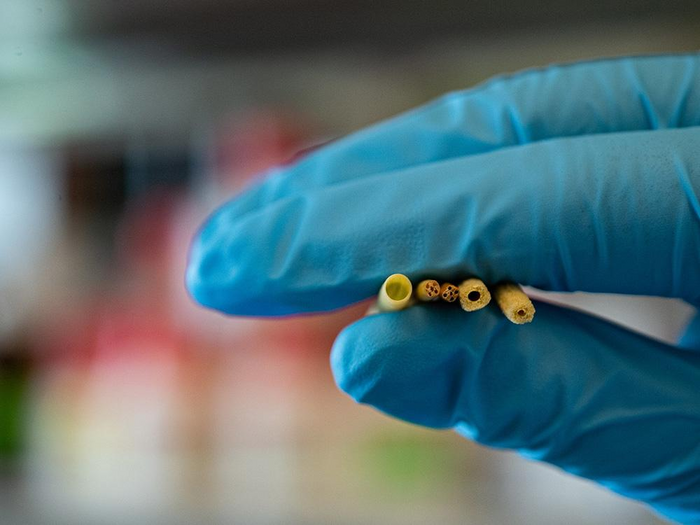UNIVERSITY PARK, Pa. — Peripheral nerves are responsible for moving muscles, sensing temperatures and even inhaling and exhaling; yet they comprise fragile fibers vulnerable to disease and injury. To maximize healing for the easily damaged nerves, Penn State researchers are using a five-year, $2.14 million grant from the National Institutes of Health’s National Institute of Neurological Disorders and Stroke to develop a biodegradable nerve scaffold that aims to employ folate and citrate in novel ways.

Credit: Kelby Hochreither/Penn State
UNIVERSITY PARK, Pa. — Peripheral nerves are responsible for moving muscles, sensing temperatures and even inhaling and exhaling; yet they comprise fragile fibers vulnerable to disease and injury. To maximize healing for the easily damaged nerves, Penn State researchers are using a five-year, $2.14 million grant from the National Institutes of Health’s National Institute of Neurological Disorders and Stroke to develop a biodegradable nerve scaffold that aims to employ folate and citrate in novel ways.
“Folate and citrate strengthen different pathways to help tissue regeneration, and we have both in one biomaterial,” said principal investigator Jian Yang, professor of biomedical engineering in the Penn State College of Engineering who is also affiliated with the Materials Research Institute. “We have been working with citrate in biomaterials for more than 16 years. Researchers have known for a while one of the benefits of using citrate as a building block for biomaterials is that when the material degrades, citrate helps to regulate cell metabolism, which in turn regulates the stem cell differentiation to help tissue regeneration.”
The use of citrate in biomaterials is not new, according to Yang, but the addition of folic acid, or vitamin B9, into the polymer backbone of their nerve scaffold is. Folate — one of the key vitamins found in prenatal vitamins because it plays a critical role in the development of the central nervous system — also plays an important, if lesser known, role in helping the peripheral nervous system develop.
Peripheral nerves have two major components: axons and Schwann cells. Axons transmit signals from the body to the brain and back again. Schwann cells “pave the road” for axons, according to Yang, and folate helps Schwann cells move to the right spot.
“Schwann cells are like the pavement on top of which the axons can grow,” Yang said. “We found that folate can promote Schwann cell migration, or ‘paving the road,’ which is a critical step to promote nerve regeneration, because the nerves have to cross the gap to grow and reconnect.”
This gap, or the nerve defect or spot of damage, is where the researchers will place the engineered and folate-fortified nerve conduit to encourage nerve regeneration.
“People may ask, ‘Why don’t I just simply take folate?’” Yang said. “But we discovered that the key for repairs is delivering a significant concentration of folate locally to promote Schwann cell migration and axon regeneration.”
The researchers can also use folate to modify the physical structure of DNA to better control how the cells develop during regeneration.
“We don’t change the DNA sequence, but we modify the DNA through DNA methylation to control the neuron cell differentiation to regrow the nerve,” Yang said. “It’s called an epigenetic stimulation. People already identified that folate can be an epigenetic factor, but no one incorporated the folate into biomaterials to make nerve conduits.”
In addition to developing the nerve conduit scaffold with folate and citate, the researchers plan to employ photoacoustic imaging to closely monitor how the materials degrade and how the tissue regenerates, along with other outcomes. Co-PI Raj Kothapalli, Penn State assistant professor of biomedical engineering, will lead this noninvasive imaging technique effort.
“When it comes to complex tissue regeneration, no individual lab can do all the work,” Yang said. “You need expertise from many different fields, which is why the collaborative nature of this project is so important.”
The other co-investigators on the project, all from Penn State, are: Sulin Zhang, professor of engineering science and mechanics and of biomedical engineering, who is also affiliated with the Materials Research Institute and the Department of Materials Science and Engineering in the College of Earth and Mineral Sciences; Cheng Dong, distinguished professor of biomedical engineering, and Elias Rizk, associate professor of neurosurgery at Penn State College of Medicine and neurosurgeon at Penn State Health.




